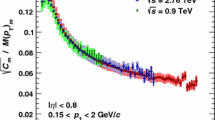Abstract.
A detailed study of Event-by-Event pseudorapidity fluctuation of the pions produced in 16O -AgBr interactions at 60A GeV and 32S -AgBr interactions at 200A GeV has been carried out in terms of \( \phi\) , a variable defined as a measure of fluctuation. Non-zero \( \phi\) values indicate the presence of strong correlation among the pions for both interactions. Multiplicity and rapidity dependence of the Event-by-Event pseudorapidity fluctuation has been investigated. A decrease of \( \phi\) with average multiplicity and increase of the same variable with pseudorapidity width are observed. Decrease of \( \phi\) with average multiplicity is concluded as the particle emission by several independent sources occurs for higher-multiplicity events. The increase in \( \phi\) values with pseudorapidity width, taken around central rapidity, might hint towards the presence of long-range correlation and its dominance over short range one. We have compared our experimental results with Monte Carlo simulation generated assuming independent particle emission. Comparison shows that the source of correlation and fluctuation is the dynamics of the pion production process. We have also compared our results with events generated by FRITIOF code. Such events also show the presence of fluctuation and correlation; however they fail to replicate the experimental findings.
Similar content being viewed by others
References
M. Luzum et al., J. Phys. G: Nucl. Part. Phys. 41, 063102 (2014)
Y. Aoki et al., Nature 443, 675 (2006)
P. Jacobs, D. Kharzeev, B. Muller, J. Nagle, K. Rajagopal, S. Vigdor, arXiv:0705.1930 [nucl-ex]
S. Jeon et al., Phys. Rev. C 73, 014905 (2006)
M. Asakawa et al., Phys. Rev. Lett. 85, 2072 (2000)
L.F. Babichev, A.N. Khmialeuski, Study the signals of QGP using Monte Carlo for Pb+Pb for Energy from 500 to 2000 GeV, in Foundations & Advances in Nonlinear Science: Proceedings of 15th International Conference-School, September 20-23, 2010, Minsk, edited by V.I. Kuvshinov, G.G. Krylov (Education and Upbringing, 2010)
M. Weber for the ALICE collaboration, J. Phys.: Conf. Ser. 389, 012036 (2012)
M. Gazdzicki, S. Mrówczynski, Z. Phys. C 54, 127 (1992)
E.V. Shuryak, Phys. Lett. B 423, 9 (1998)
A. Bialas, V. Koch, Phys. Lett. B 456, 1 (1999)
NA49 Collaboration (H. Appelshäuser et al.), Phys. Lett. B 459, 679 (1999)
G. Baym, H. Heiselberg, Phys. Lett. B 469, 7 (1999)
G. Danilov, E. Shuryak, nucl-th/9908027
T. Anticic et al., Phys. Rev. C 70, 034902 (2004)
S. Jeon, V. Koch, Event-by-event fluctuations, in Quark Gluon Plasma, edited by R.C. Hwa, X.N. Wang (World Scientific, Singapore, 2003) p. 430, arXiv:hep-ph/0304012
H. Heiselberg, Phys. Rep. 351, 161 (2001)
T.K. Nayak, J. Phys. G: Nucl. Part. Phys. 32, S187 (2006) arXiv:nucl-ex/060802
M. Stephanov et al., Phys. Rev. Lett. 81, 4816 (1998)
M. Stephanov et al., Phys. Rev. D 61, 114028 (1999)
S. Bhattacharyya et al., Phys. Lett. B 726, 194 (2013)
G. Roland, Nucl. Phys. A 638, 91c (1998)
M. Belkacem, arXiv:nucl-th/9903017v2, 22 April 1999
ATLAS Collaboration (G. Aad), arXiv:1305.2942v1 [hep-ex].
S.A. Voloshin et al., Phys. Rev. C 60, 024901 (1999)
B. Abelev et al., Eur. Phys. J. C 74, 3077 (2014)
J. Adams et al., Phys. Rev. C 72, 044902 (2005)
KLM Collaboration (M.L. Cherry et al.), Acta Phys. Pol. B 29, 2129 (1998)
G. Singh et al., Phys. Rev. Lett. 61, 1073 (1988)
K. Sengupta et al., Phys. Lett. B 213, 548 (1988)
K. Sengupta et al., Phys. Lett. B 236, 219 (1989)
C.F. Powell, P.H. Fowler, D.H. Perkins, Study of Elementary Particles by the Photographic Method (Pergamon, Oxford, 1959) pp. 450--464 and references therein
D. Ghosh et al., Phys. Rev. C 59, 2286 (1999)
D. Ghosh et al., J. Phys. G: Nucl. Part. Phys. 38, 065105 (2011)
D. Ghosh et al., Phys. Rev. C 52, 2092 (1995)
G. Roland, NA49 Collaboration, Proceedings of the Hirschegg Workshop on QCD Phase Transitions, edited by H. Feldmeier, Joern Knoll, W. Noerenberg, J. Wambach (GSI, Darmstadt, 1997) p. 309
M. Gazdzicki et al., Eur. Phys. J. C 6, 365 (1999)
M. Bleicher et al., Phys. Lett. B 435, 9 (1998)
S. Mrówczynski, Phys. Lett. B 439, 6 (1998)
D. Ghosh et al., J. Phys. G: Nucl. Part. Phys. 39, 105101 (2012)
B. Nilsson-Almqvist, E. Stenlund, Comput. Phys. Commun. 43, 387 (1987)
B. Andersson et al., Nucl. Phys. B 281, 289 (1987)
S. Dhamija et al., J. Phys. G: Nucl. Part. Phys. 28, 1239 (2002)
D. Ghosh et al., Pramana J. Phys. 77, 297 (2011)
D. Chanda et al., Phys. Rev. C 71, 034904 (2005)
B. Nilsson-Almqvist et al., Comput. Phys. Commun. 43, 387 (1987)
A. Beiser, Rev. Mod. Phys. 24, 273 (1952)
C. Adler, arXiv:nucl-ex/0206008v1 (2002)
I.C. Arsene, arXiv:0911.2586v2 [nucl-ex] (2009)
S. Bhattacharyya et al., J. Phys. G: Nucl. Part. Phys. 40, 025105 (2013)
Author information
Authors and Affiliations
Additional information
Communicated by D. Pierroutsakou
Rights and permissions
About this article
Cite this article
Bhoumik, G., Bhattacharyya, S., Deb, A. et al. Event-by-Event pseudorapidity fluctuation analysis: An outlook to multiplicity and phase space dependence. Eur. Phys. J. A 52, 196 (2016). https://doi.org/10.1140/epja/i2016-16196-8
Received:
Revised:
Accepted:
Published:
DOI: https://doi.org/10.1140/epja/i2016-16196-8




